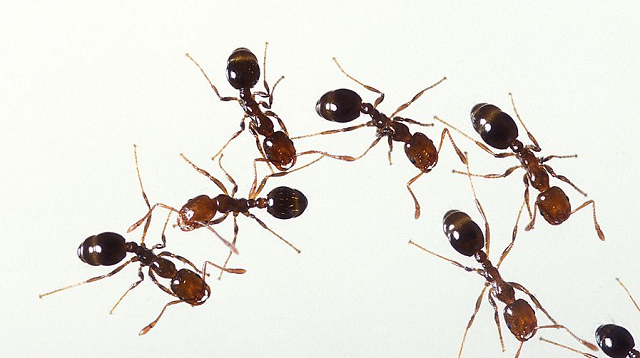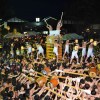
Pain-inducing insects also spotted in port of Japan’s second largest city.
As one of the biggest naval shipping hubs in the world, things are always pretty busy at the Port of Tokyo. On Thursday, though, there was an extra dose of commotion that came from something other than the fast pace of international commerce or the complexities of maritime navigation.
On June 18, workers at the Harumi Wharf in Tokyo’s Koto Ward discovered more than 200 fire ants in the facility. Those who mentally file all varieties of insects into the broad category of “disgusting creepy crawly things” will be relieved to know that fire ants do not, in fact, have the ability to shoot fire from their mouths…but on the other hand, everyone will be dismayed to learn/be reminded that fire ants get their name because after they bite into you with their mandibles they pierce your flesh with a stinger on their abdomen, then inject a venom that causes a painful burning directly into the wound. In extreme cases, the toxin can even kill people who are allergic to it.
▼ Fire ants
The fire ants were found in the wharf’s container yard, and agents from Japan’s Ministry of the Environment are helping in their extermination. However, neither the ants’ queen nor their nest was located, meaning that wiping out the insects seen on Thursday is, at best, a temporary solution.
The incident follows a previous infestation of fire ants at the wharf which took place in September and October of last year and involved the extermination of over 50 fire ant queens. Last week’s ants were spotted approximately one kilometer (0.6 miles) from where the previous groups were, making it unclear if they’re survivors of the previous purge or a new cluster. In addition, the discovery of the new group of Tokyo fire ants comes just one week after workers at the port of Yokohama, roughly 30 minutes south of Tokyo, found more than 300 fire ants on June 11.
The Ministry of the Environment is laying out poisoned bait in hopes that any remaining ants will take it back to their nests and inadvertently wipe out their colony, but cautions that fire ants become more active as the weather gets warmer, and urges anyone spotting suspicious looking ants avoid physical contact with them and contact the ministry.
Sources: NHK News Web, Livedoor News/Kyodo
Top image: Pakutaso
Insert image: Wikipedia/Anna Frodesiak
● Want to hear about SoraNews24’s latest articles as soon as they’re published? Follow us on Facebook and Twitter!


 Bug hunt! Some areas offering rewards for alien beetles threatening Japan’s cherry blossoms
Bug hunt! Some areas offering rewards for alien beetles threatening Japan’s cherry blossoms We try eating insects — they don’t taste like chicken
We try eating insects — they don’t taste like chicken Biker gang crashes Coming of Age Ceremony in real life anime moment
Biker gang crashes Coming of Age Ceremony in real life anime moment We visit “Rice and Circus,” a restaurant that combines bugs and Japanese-style cooking【Photos】
We visit “Rice and Circus,” a restaurant that combines bugs and Japanese-style cooking【Photos】 Better than mosquito repellent – The most eco-friendly (and spiritual) way to repel pests in Japan
Better than mosquito repellent – The most eco-friendly (and spiritual) way to repel pests in Japan McDonald’s new Happy Meals offer up cute and practical Sanrio lifestyle goods
McDonald’s new Happy Meals offer up cute and practical Sanrio lifestyle goods More foreign tourists than ever before in history visited Japan last month
More foreign tourists than ever before in history visited Japan last month Starbucks reopens at Shibuya Scramble Crossing with new look and design concept
Starbucks reopens at Shibuya Scramble Crossing with new look and design concept Is the new Shinkansen Train Desk ticket worth it?
Is the new Shinkansen Train Desk ticket worth it? The oldest tunnel in Japan is believed to be haunted, and strange things happen when we go there
The oldest tunnel in Japan is believed to be haunted, and strange things happen when we go there Dogs now allowed on Catbus! Ghibli Park vehicles revise service animal policy
Dogs now allowed on Catbus! Ghibli Park vehicles revise service animal policy Our reporter takes her 71-year-old mother to a visual kei concert for the first time
Our reporter takes her 71-year-old mother to a visual kei concert for the first time Arrest proves a common Japanese saying about apologies and police
Arrest proves a common Japanese saying about apologies and police Hey, Japanese taxi driver! Take us to your favorite restaurant in Tsuruga City!
Hey, Japanese taxi driver! Take us to your favorite restaurant in Tsuruga City! “Half-naked men only in loincloths” drum battle returns to Hida festival for first time in five years
“Half-naked men only in loincloths” drum battle returns to Hida festival for first time in five years Disney princesses get official manga makeovers for Manga Princess Cafe opening in Tokyo
Disney princesses get official manga makeovers for Manga Princess Cafe opening in Tokyo We try out “Chan Ramen”, an underground type of ramen popular in the ramen community
We try out “Chan Ramen”, an underground type of ramen popular in the ramen community Foreign English teachers in Japan pick their favorite Japanese-language phrases【Survey】
Foreign English teachers in Japan pick their favorite Japanese-language phrases【Survey】 Beautiful new Final Fantasy T-shirt collection on the way from Uniqlo【Photos】
Beautiful new Final Fantasy T-shirt collection on the way from Uniqlo【Photos】 There’s a park inside Japan where you can also see Japan inside the park
There’s a park inside Japan where you can also see Japan inside the park New Studio Ghibli bedding sets are cool in all senses of the word
New Studio Ghibli bedding sets are cool in all senses of the word Japanese convenience store packs a whole bento into an onigiri rice ball
Japanese convenience store packs a whole bento into an onigiri rice ball Hanton rice — a delicious regional food even most Japanese people don’t know about, but more should
Hanton rice — a delicious regional food even most Japanese people don’t know about, but more should New Pokémon cakes let you eat your way through Pikachu and all the Eevee evolutions
New Pokémon cakes let you eat your way through Pikachu and all the Eevee evolutions Hamburg and Hamburg Shibuya: A Japanese restaurant you need to put on your Tokyo itinerary
Hamburg and Hamburg Shibuya: A Japanese restaurant you need to put on your Tokyo itinerary Studio Ghibli releases Kiki’s Delivery Service chocolate cake pouches in Japan
Studio Ghibli releases Kiki’s Delivery Service chocolate cake pouches in Japan Japan’s bone-breaking and record-breaking roller coaster is permanently shutting down
Japan’s bone-breaking and record-breaking roller coaster is permanently shutting down New definition of “Japanese whiskey” goes into effect to prevent fakes from fooling overseas buyers
New definition of “Japanese whiskey” goes into effect to prevent fakes from fooling overseas buyers Foreign passenger shoves conductor on one of the last full runs for Japan’s Thunderbird train
Foreign passenger shoves conductor on one of the last full runs for Japan’s Thunderbird train Our Japanese reporter visits Costco in the U.S., finds super American and very Japanese things
Our Japanese reporter visits Costco in the U.S., finds super American and very Japanese things Kyoto bans tourists from geisha alleys in Gion, with fines for those who don’t follow rules
Kyoto bans tourists from geisha alleys in Gion, with fines for those who don’t follow rules Studio Ghibli unveils Mother’s Day gift set that captures the love in My Neighbour Totoro
Studio Ghibli unveils Mother’s Day gift set that captures the love in My Neighbour Totoro Domino’s Japan now sells…pizza ears?
Domino’s Japan now sells…pizza ears? New Japanese KitKat flavour stars Sanrio characters, including Hello Kitty
New Japanese KitKat flavour stars Sanrio characters, including Hello Kitty Kyoto creates new for-tourist buses to address overtourism with higher prices, faster rides
Kyoto creates new for-tourist buses to address overtourism with higher prices, faster rides Sales of Japan’s most convenient train ticket/shopping payment cards suspended indefinitely
Sales of Japan’s most convenient train ticket/shopping payment cards suspended indefinitely Sold-out Studio Ghibli desktop humidifiers are back so Totoro can help you through the dry season
Sold-out Studio Ghibli desktop humidifiers are back so Totoro can help you through the dry season Japanese government to make first change to romanization spelling rules since the 1950s
Japanese government to make first change to romanization spelling rules since the 1950s Ghibli founders Toshio Suzuki and Hayao Miyazaki contribute to Japanese whisky Totoro label design
Ghibli founders Toshio Suzuki and Hayao Miyazaki contribute to Japanese whisky Totoro label design Doraemon found buried at sea as scene from 1993 anime becomes real life【Photos】
Doraemon found buried at sea as scene from 1993 anime becomes real life【Photos】 Tokyo’s most famous Starbucks is closed
Tokyo’s most famous Starbucks is closed One Piece characters’ nationalities revealed, but fans have mixed opinions
One Piece characters’ nationalities revealed, but fans have mixed opinions We asked a Uniqlo employee what four things we should buy and their suggestions didn’t disappoint
We asked a Uniqlo employee what four things we should buy and their suggestions didn’t disappoint Princesses, fruits, and blacksmiths: Study reveals the 30 most unusual family names in Japan
Princesses, fruits, and blacksmiths: Study reveals the 30 most unusual family names in Japan Studio Ghibli’s new desktop Howl’s Moving Castle will take your stationery on an adventure
Studio Ghibli’s new desktop Howl’s Moving Castle will take your stationery on an adventure Japanese hobbyist makes real tiny pizzas in a fully working, smoking miniature wood-fired oven!
Japanese hobbyist makes real tiny pizzas in a fully working, smoking miniature wood-fired oven! Think mosquitoes suck? Japan’s Shock Extermination Stick lets you suck some mosquitoes instead
Think mosquitoes suck? Japan’s Shock Extermination Stick lets you suck some mosquitoes instead Sun + Magnifying glass = Art? One man’s unique “painting” style will blow your mind
Sun + Magnifying glass = Art? One man’s unique “painting” style will blow your mind Spot discovered on the Taipei Bridge without a scooter on it
Spot discovered on the Taipei Bridge without a scooter on it Earth Chemical to change name of insecticide products to “insect care products”
Earth Chemical to change name of insecticide products to “insect care products” Mr. Sato meets a familiar friend in this electronics lucky bag from Akihabara 【Photos】
Mr. Sato meets a familiar friend in this electronics lucky bag from Akihabara 【Photos】 Anti-insect laser gun turrets designed by Osaka University, expected to work on roaches too
Anti-insect laser gun turrets designed by Osaka University, expected to work on roaches too Three centipede and cockroach species are newly named and placed under protection in Okinawa
Three centipede and cockroach species are newly named and placed under protection in Okinawa We try Starbucks Japan’s new tongue-twister Frappuccino
We try Starbucks Japan’s new tongue-twister Frappuccino Gamer goes to play naval-themed anime game at Japanese arcade, finds real sailors already there
Gamer goes to play naval-themed anime game at Japanese arcade, finds real sailors already there Happy news: Japanese NPO ships “poop protectors” to save swallow nests in train stations 【Pics】
Happy news: Japanese NPO ships “poop protectors” to save swallow nests in train stations 【Pics】 Anime studio attacked by arsonist, explosion leaves dozens injured, 12 dead
Anime studio attacked by arsonist, explosion leaves dozens injured, 12 dead Fed-up Japanese city hires a hawk to chase occupying army of crows away from city hall【Videos】
Fed-up Japanese city hires a hawk to chase occupying army of crows away from city hall【Videos】 New taiko gacha capsule toys let you play Japanese drums with true-to-life sound
New taiko gacha capsule toys let you play Japanese drums with true-to-life sound Google Maps sent us to a forbidden exit from one of Tokyo’s major subway stations
Google Maps sent us to a forbidden exit from one of Tokyo’s major subway stations
Leave a Reply